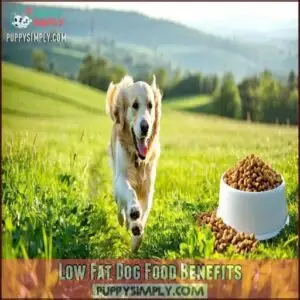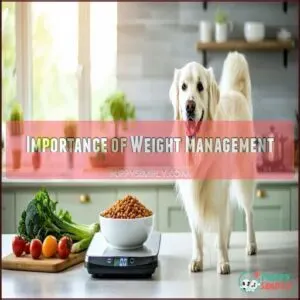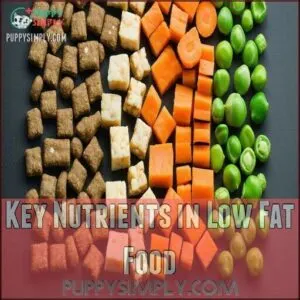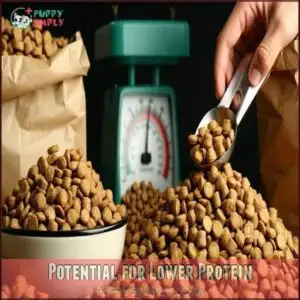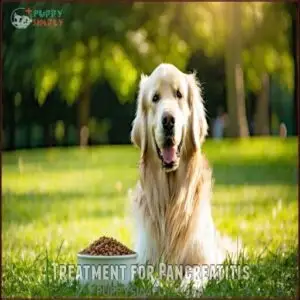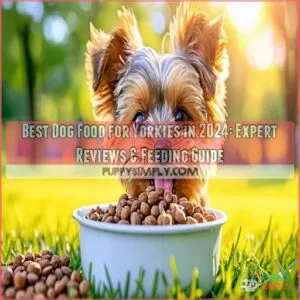This site is supported by our readers. We may earn a commission, at no cost to you, if you purchase through links.

Look for recipes with lean protein, like chicken or fish, paired with balanced fiber to support digestion.
Brands like Blue Buffalo Healthy Weight or Nulo Freestyle Adult Trim are known for quality, and it’s crucial to ensure the fat-to-protein ratio fits your dog’s needs and watch out for unnecessary fillers.
Switching gradually is key to avoiding upset stomachs, and feeding the right food keeps tails wagging and paws active—because a healthy dog is a happy dog!
Let’s explore options fit for your pup.
Table Of Contents
- Key Takeaways
- Low Fat Dog Food Benefits
- Importance of Weight Management
- Key Nutrients in Low Fat Food
- Choosing The Right Low Fat Food
- Top 9 Low Fat Dog Foods
- 1. Grain Free High Protein Dog Food
- 2. Weight Control Dog Food Formula
- 3. Healthy Weight Dog Food Chicken
- 4. Blue Buffalo Life Protection Healthy Weight Dog Food
- 5. Fromm Gold Weight Management Dog Food
- 6. Grain Free Lean Dog Food
- 7. Nulo Freestyle Adult Trim Grain Free Dog Food
- 8. Nulo Freestyle Adult Trim Cod Lentils Dog Food
- 9. Weruva Chicken Dog Food 12 Cans
- Pancreatitis and Diet
- Low Fat Diets for Health Issues
- Transitioning to Low Fat Food
- Maintaining a Healthy Weight
- Consultation and Nutrition
- Frequently Asked Questions (FAQs)
- What food is best for dogs with pancreatitis?
- What is the best dog food for overweight dogs?
- What is considered low-fat for a dog with pancreatitis?
- What is the best food to give your dog to lose weight?
- What is the lowest fat content dog food?
- What is the number one healthiest dog food?
- What is considered low-fat food for dogs?
- What low-fat meats are good for dogs with pancreatitis?
- What foods will help a dog lose weight?
- What meat is low in fat for dogs?
- Conclusion
Key Takeaways
- Look for low-fat dog food with high-quality protein sources like chicken, turkey, or fish to support muscle maintenance while managing weight.
- Choose dog food with less than 10% fat for dry food or 5% for wet food to reduce strain on your dog’s pancreas and help prevent pancreatitis.
- Transition gradually to low-fat dog food over 7-10 days, monitoring your dog’s stool consistency, energy levels, and appetite to ensure they’re adapting well.
- Combine low-fat dog food with portion control, regular exercise, and limited treats to maintain a healthy weight and improve your dog’s overall wellbeing.
Low Fat Dog Food Benefits
Feeding your dog low-fat food can help manage their weight, reduce the risk of pancreatitis, and support overall health.
Low-fat dog food promotes weight control, reduces pancreatitis risk, and supports your pup’s health for a happier, more active life.
It’s an effective way to address specific health concerns while keeping them active and comfortable.
Weight Management for Dogs
Managing your dog’s weight is essential for their health.
Keeping your dog’s weight in check lays the foundation for a healthier, happier, and more active life.
Low fat dog food helps with calorie control, especially for breeds prone to obesity.
Combine this with portion sizes adapted to their needs and an exercise regimen that suits their energy level.
Lifestyle changes, like switching to low calorie dog food, help weight management dog diets stay effective and sustainable long-term.
Reduced Risk of Pancreatitis
Pancreatitis prevention starts with understanding how dietary fats affect enzyme function and inflammation control.
Low fat dog food helps manage dietary fat content, reducing strain on your dog’s pancreas. Some breeds are more prone to dog pancreatitis, making lowfat diets a safer choice.
By controlling inflammation, you’re protecting your pet’s health and avoiding painful flare-ups linked to high-fat diets. This approach is crucial for managing dietary fat content and overall well-being.
Improved Joint Health
Low fat dog food doesn’t just help with weight; it supports joint health too.
Excess weight strains joints, especially in senior dogs.
By promoting weight impact reduction and inflammation reduction, these foods enhance mobility and exercise benefits.
Look for healthy dog food options with:
- Cartilage support nutrients like glucosamine
- Balanced protein for strength
- Omega-3 fatty acids for inflammation reduction
- Fiber for weight management
Importance of Weight Management
Keeping your dog at a healthy weight is essential for their overall well-being and longevity. It reduces the risk of serious health issues like joint problems, diabetes, and heart disease.
Health Risks of Obesity
Dog obesity isn’t just about extra pounds—it’s a serious health risk.
Excess weight puts stress on joints, increases heart disease and diabetes risk, and can lead to breathing problems.
It even shortens a dog’s lifespan.
Using low fat dog food as part of a weight management dog plan can support dog weight loss and promote a healthier, happier life.
Benefits of Healthy Weight
A healthy weight does wonders for your dog’s well-being. It improves mobility, reduces strain on joints, and supports organ function. Plus, it can extend their lifespan!
Here’s why weight management dog food matters:
- Enhances energy for playtime.
- Prevents obesity-related diseases.
- Lowers risk of pancreatitis.
- Promotes better digestion.
- Maintains muscle tone with low-calorie dog food.
Key Nutrients in Low Fat Food
When choosing low-fat dog food, you need to focus on key nutrients that support your pet’s health.
High-quality proteins, essential fatty acids, and balanced fiber are essential for maintaining energy, digestion, and overall well-being.
High-Quality Protein Sources
A healthy weight starts with the right nutrients, and high-quality protein is key.
Look for real meat like chicken meal or turkey, not fillers.
High protein dog foods support muscle maintenance while staying lean.
Novel proteins like fish or duck help dogs with allergies.
Protein digestibility matters—choose options rich in amino acids for energy and overall health in low fat dog food.
Essential Fatty Acids
High-quality protein is essential, but don’t overlook the power of essential fatty acids in low fat dog food.
These omega sources boost skin health, brain function, and joint support.
Look for:
- Fish oil or flaxseed for balanced omega-3s.
- Poultry for omega-6 and a shiny coat.
- Whitefish for inflammation control.
- Vet-recommended options to avoid supplementation risks.
Balanced Fiber Content
Balanced fiber content in low fat dog food plays a key role in weight management and digestive health.
It improves stool quality, supports the gut microbiome, and guarantees an adequate amount for your dog’s needs.
Fiber sources like beet pulp and pumpkin are common in dog food fiber formulations.
Federal regulations oversee supplement label accuracy.
| Fiber Benefits | Example Fiber Sources | Impact on Dogs |
|---|---|---|
| Supports digestion | Beet pulp | Better stool quality |
| Aids weight control | Pumpkin | Healthy weight |
| Gut microbiome health | Flaxseed | Improved digestion |
The benefits of fiber in dog food include supporting the gut microbiome, aiding in digestive health, and providing better stool quality.
Choosing The Right Low Fat Food
When choosing the right low-fat dog food, focus on options with a balanced fat-to-protein ratio and quality ingredients.
Consider your dog’s specific health needs, as well as the cost and availability of the food, to ensure you make an informed decision with a balanced approach.
Fat-to-Protein Ratio
Understanding the fat-to-protein ratio helps you pick the best low-fat dog food.
Aim for an ideal ratio under 70%, balancing dietary fat and calorie density while preserving muscle mass.
High-quality protein supports energy and recovery, especially for dogs with pancreatitis.
Protein-sparing fat sources guarantee your dog stays healthy without overloading their system.
Always check labels and consult your vet. Some brands offer grain-free options for sensitive puppies.
Potential for Lower Protein
When you choose lowfat dog food, remember that reducing dietary fat can lower protein levels.
This might affect muscle mass if highquality protein sources aren’t included.
Look for dog food low in fat with proper supplementation to maintain essential amino acids. A good fat-protein ratio guarantees digestibility issues don’t arise, keeping your pup healthy and strong.
Many owners actively seek low protein options for specific health needs.
Cost and Availability
When considering low-fat dog food, diet cost and brand availability matter.
Prescription diets can be pricey but often necessary for specific health needs.
Look for affordable dog food options with transparent ingredient sourcing.
Dog food price varies by quality, but budget options exist.
Check dog food online availability or retail platforms for deals, ensuring both affordability and accessibility for your pup.
Top 9 Low Fat Dog Foods
Finding the right low-fat dog food can make a big difference in your pet’s health, especially if they struggle with weight or pancreatitis.
We’ve compiled a list of the top nine options to help you choose the best fit for your dog’s needs.
1. Grain Free High Protein Dog Food
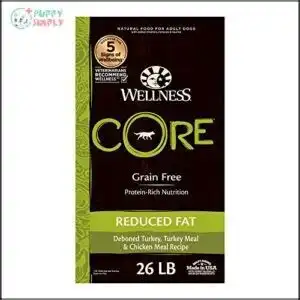
Grain-free high-protein dog food is a great option for dogs needing low-fat diets without sacrificing nutrition.
These formulas prioritize quality proteins like turkey, chicken, or fish, supporting muscle maintenance and energy.
By excluding grains, they’re also ideal for dogs with allergies or sensitivities.
Many options, like Wellness CORE Reduced Fat, balance protein with reduced fat levels to aid weight management.
Always check the fat percentage (below 10%) to confirm it meets your dog’s needs.
Consult your vet before switching to these diets.
Best For: Dogs with grain allergies, weight management needs, or those requiring high protein for muscle and energy support.
- Higher price compared to some alternatives.
- Fat percentage may still be too high for some needs.
- Requires vet consultation for dogs with specific health issues.
- High-protein formula supports muscle maintenance and energy.
- Grain-free to reduce allergies and digestive issues.
- Includes probiotics, omega fats, and antioxidants for overall health.
2. Weight Control Dog Food Formula
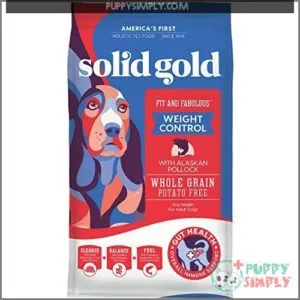
Finding the right weight control dog food formula can feel like striking gold for dogs needing a low-fat diet.
Balanced options like Purina Pro Plan and Nutrience Care Weight Management offer high protein levels to maintain muscle, with reduced fat for healthy weight support.
These formulas include fiber to aid digestion and probiotics for immune health.
Royal Canin’s Satiety adds joint-supporting glucosamine, while VēRUS features metabolic-boosting L-Carnitine.
Each option suits weight-conscious, health-focused pups, ensuring nutritional needs are met without extra calories.
Best For: Dogs needing a weight management diet with support for digestion, immune health, and overall vitality.
- Some formulas may include grains that aren’t suitable for dogs with sensitivities.
- Premium quality options can be costly depending on the brand.
- Availability may vary, with some products only accessible online or via specific platforms.
- High protein levels help maintain muscle while promoting weight loss.
- Includes probiotics and fiber to support healthy digestion.
- Offers additional ingredients like glucosamine for joint health or L-Carnitine for metabolism.
3. Healthy Weight Dog Food Chicken
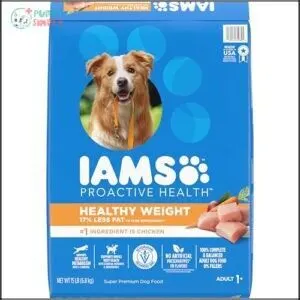
In regards to managing your dog’s weight without sacrificing taste, chicken-based healthy weight dog food is a standout choice.
Packed with high-quality protein, these diets help build strong muscles while maintaining lower fat content.
They’re great for less active or indoor dogs needing weight control, and look for balanced formulas with essential vitamins, fiber, and probiotics to support digestion and overall health.
Choosing options with L-Carnitine can also boost metabolism, and gradual switching guarantees happy paws and wagging tails during the switch, making it a great way to support your dog’s overall health.
Best For: Adult dogs needing weight management, especially less active or indoor dogs.
- High-quality protein supports strong muscles.
- Reduced fat content aids in weight management.
- Includes L-Carnitine for a metabolism boost.
- Requires gradual transition to avoid digestion issues.
- May not suit dogs with grain sensitivities.
- Limited variety of flavors available.
4. Blue Buffalo Life Protection Healthy Weight Dog Food
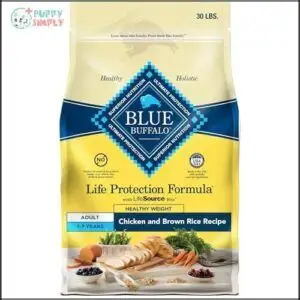
Blue Buffalo Life Protection Healthy Weight Dog Food is a great option if you’re aiming for controlled weight management.
With real chicken as the first ingredient, it supports lean muscle development.
Its LifeSource Bits provide antioxidants, vitamins, and minerals, boosting immune health.
Featuring lower-calorie content and natural ingredients, it avoids by-products, corn, wheat, and soy, making it gentle on sensitive stomachs.
Omega fatty acids enhance coat health, while glucosamine supports joints.
Though pricier, it’s worth it for quality-focused dog owners who prioritize their pet’s well-being and are looking for a food that supports lean muscle development.
Best For: Dog owners seeking a high-quality, natural food option to support healthy weight management and lean muscle development in adult dogs.
- Real chicken as the first ingredient supports lean muscle development.
- Free from by-products, corn, wheat, and soy, making it suitable for sensitive stomachs.
- Includes Omega fatty acids, glucosamine, and antioxidants for coat, joint, and immune health.
- Higher price point compared to standard dog food.
- Picky eaters may not prefer the taste.
- Limited flavor variety may not appeal to all dogs.
5. Fromm Gold Weight Management Dog Food
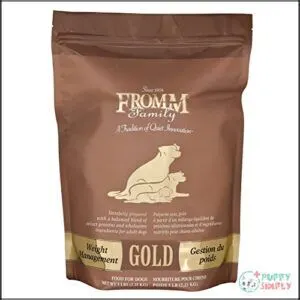
Fromm Gold Weight Management Dog Food is a solid choice if weight control is your focus.
Crafted with wild-caught whitefish and salmon, it supports lean muscle growth and fat utilization thanks to added L-carnitine.
This formula includes probiotics, aiding digestion, plus natural antioxidants for immune health.
With options for different bag sizes, it’s cost-effective and convenient.
Collagen supports joints, making it ideal for older dogs or those with mobility issues.
It’s a premium option for your dog’s health and happiness.
Best For: Dogs needing weight management, joint support, and improved digestion with premium ingredients.
- Contains wild-caught whitefish and salmon for lean muscle support.
- Includes L-carnitine for improved fat utilization.
- Probiotics and antioxidants enhance digestion and immune health.
- Higher price compared to standard dog food brands.
- Not grain-free, which may not suit all dietary needs.
- Limited availability in smaller bag sizes.
6. Grain Free Lean Dog Food
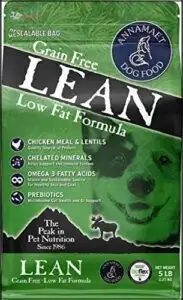
Grain Free Lean Dog Food stands out for its half-fat formula compared to regular options, making it a lifesaver for dogs needing weight management or dealing with pancreatitis.
It combines premium protein sources like chicken meal and lentils with gut-friendly prebiotics.
Packed with omega-3 fatty acids, it supports a shiny coat and healthy skin.
Plus, the addition of L-carnitine helps boost fat metabolism, ensuring lean muscle development, perfect for large breed puppies or adult dogs, it’s both nutritious and satisfying.
Best For: Dog owners seeking a grain-free, low-fat formula for weight management, large breed puppies, or dogs with pancreatitis.
- Half-fat recipe aids in weight management and supports lean muscle.
- Includes L-carnitine and omega-3 fatty acids for overall health and a shiny coat.
- High-quality protein sources like chicken meal and lentils for balanced nutrition.
- Some dogs may not enjoy the taste without mixing with other foods.
- Higher price compared to standard dog foods.
- Limited flavor options available in this specific formula.
7. Nulo Freestyle Adult Trim Grain Free Dog Food
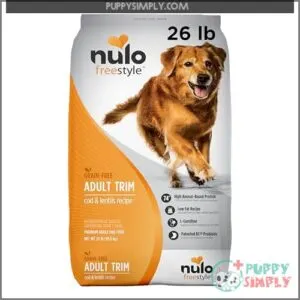
Nulo Freestyle Adult Trim Grain Free Dog Food is a standout choice for managing weight and supporting lean muscle.
It provides quality nutrition while keeping fat and carbs low.
The grain-free recipe avoids common allergens like soy and wheat, making it perfect for sensitive stomachs.
Key ingredients like cod, turkey meal, and lentils deliver balanced fiber for digestion.
Fortified with L-Carnitine and probiotics, it aids fat metabolism and immunity, helping your dog stay active and healthy, with 74% animal-based protein.
Best For: Dogs needing weight management, lean muscle support, or a grain-free diet for sensitive stomachs.
- High in animal-based protein to promote lean muscle mass.
- Grain-free formula avoids common allergens like wheat and soy.
- Fortified with probiotics and L-Carnitine for digestion and fat metabolism.
- Higher price compared to other low-fat dog foods.
- Not widely available in local pet stores.
- Occasional concerns about packaging quality (e.g., slashed bags).
8. Nulo Freestyle Adult Trim Cod Lentils Dog Food
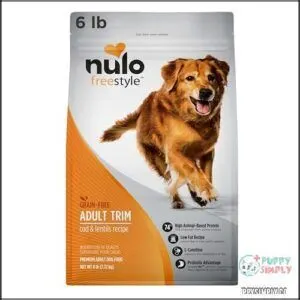
Nulo Freestyle Adult Trim Cod Lentils Dog Food is a top-tier choice for managing weight and supporting dogs with pancreatitis.
Packed with 74% animal-based protein from quality sources like deboned cod and turkey meal, this grain-free formula boosts lean muscle while promoting digestion with prebiotic fiber and probiotics.
With just 7–9% crude fat and L-Carnitine for fat metabolism, it’s perfect for dogs needing a low-fat diet.
Its small kibble size and tasty recipe even satisfy picky eaters, making it suitable for adult dogs seeking better overall health.
Best For: Dogs needing a low-fat, high-protein diet for weight management or dealing with conditions like pancreatitis.
- High-quality animal-based protein supports lean muscle.
- Grain-free and easy to digest due to prebiotic fiber and probiotics.
- Small kibble size and appealing taste for picky eaters.
- Higher price compared to some alternatives.
- Some customers report packaging issues.
- Limited availability in local pet stores.
9. Weruva Chicken Dog Food 12 Cans

Weruva Chicken Dog Food, featuring tender white-meat chicken in gravy, is perfect for dogs needing low-fat, high-protein meals.
It’s grain-free, gluten-free, and packed with added vitamins and minerals to support balanced nutrition.
Manufactured in human food facilities, it guarantees superb quality and safety.
With just 2.20% fat, it’s ideal for dogs managing pancreatitis or weight issues.
Though pricier and occasionally inconsistent in chicken-to-gravy ratio, it’s a top choice for picky eaters or pets with sensitive stomachs.
Dogs love its fresh, flavorful taste!
Best For: Dogs with sensitive stomachs, pancreatitis, or picky eating habits.
- Expensive compared to other brands.
- Occasional inconsistency in chicken-to-gravy ratio.
- Reports of damaged cans during shipping.
- High-quality, human-grade ingredients.
- Grain-free and gluten-free for easy digestion.
- Low-fat content suitable for weight management and pancreatitis.
Pancreatitis and Diet
If your dog has pancreatitis, what they eat plays a major role in their recovery and overall health.
A low-fat diet helps reduce strain on the pancreas, making it easier for your pet to digest food and stay comfortable, with low-fat diet being crucial.
Causes of Pancreatitis
Pancreatitis can stem from dietary indiscretion like table scraps or fatty foods.
Genetic predisposition affects breeds such as Miniature Schnauzers. Medication side-effects and abdominal trauma are other triggers.
Hyperlipidemia causes, often linked to high fat in a dog’s diet, increase risk. A low-fat diet is essential for dogs with this condition.
Follow veterinary recommendations and consider low-fat dog food to help manage this painful condition and support overall health.
Symptoms of Pancreatitis
Spotting pancreatitis early can save your dog discomfort.
Watch for these symptoms:
- Abdominal pain causing restlessness or whining.
- Vomiting frequency that disrupts digestion.
- Appetite loss, even for favorite treats.
- Lethargy signs, like unusual disinterest.
- Dehydration risks, shown by dry gums or sunken eyes.
If you notice these, consult your vet promptly.
Low-fat dog food supports digestive and gastrointestinal health.
Treatment for Pancreatitis
Managing pancreatitis requires a veterinarian-recommended approach.
Key treatments include a low-fat dog diet to reduce stress on the pancreas, pain management, and fluid therapy to avoid dehydration.
Enzyme supplementation may support digestive health.
Regular monitoring of recovery is necessary to confirm progress.
Dietary restrictions like lowfat dog food can help your pup feel better while keeping inflammation at bay, which is crucial for pain management.
Low Fat Diets for Health Issues
You’ll find that low-fat diets can make a big difference for dogs dealing with liver disease, pancreatitis, or gastrointestinal problems.
By reducing fat intake, you’re helping your dog maintain a healthy weight and avoid complications tied to these conditions.
Liver Disease and Dietary Needs
Liver disease causes unique dog dietary needs, requiring careful attention to fat in dog diets.
Lowfat dog food supports reduced toxin buildup and bile acid support, aiding digestion and liver health.
Liver-friendly nutrients like Vitamin E and antioxidants promote healing, while avoiding medication interactions.
Prioritize lowfat dog nutrition with easily digestible proteins—your canine’s health depends on it!
Gastrointestinal Issues and Low-Fat Diets
Dogs with sensitive stomachs or IBD thrive on low-fat diets.
These foods support digestive health and nutrient absorption while being easy on the gut.
Look for:
- Easily digestible proteins like chicken or fish.
- Prebiotics to nourish the gut microbiome.
- Digestive enzymes for smooth digestion.
- Balanced fiber levels to ease inflammation.
- Low-fat formulas for better canine digestive health.
Obesity and Weight Management
Obesity in dogs affects their health and lifespan, but a lowfat diet paired with an exercise regimen can make a difference.
Factors like breed predisposition and metabolic rate influence weight management. Use diet dog food or dog food low in fat to balance calorie restriction effectively.
Portion control guarantees your dog maintains a healthy weight while enjoying low calorie dog meals.
Transitioning to Low Fat Food
Switching your dog to a low-fat diet takes patience and careful planning to guarantee their health isn’t disrupted.
Start with a gradual shift to help their digestive system adjust smoothly and avoid any unwanted side effects, ensuring a smooth transition for their overall well-being.
Gradual Transitioning Tips
When switching to low fat dog food, start slow.
Mix small amounts with your dog’s current food, adjusting over a 7-10 day Conversion Timeline.
Pay attention to Mixing Ratios, Digestive Monitoring, and any Allergy Concerns.
Gradual changes help avoid upset stomachs, especially for dogs with sensitive stomachs or specific dietary needs.
Consider a proper food switch for best results.
Always check dog food ingredients for palatability issues.
Monitoring Your Dog’s Response
Keep a close eye on stool consistency, energy levels, appetite changes, coat condition, and hydration status as your dog adjusts to a lowfat canine formula.
Subtle shifts can signal how well they’re tolerating the new food, especially if they’ve pancreatitis or inflammatory bowel disease.
An easily digestible, vet-recommended formula should support smooth digestion and overall health improvements.
Potential Challenges and Solutions
Adjusting to dog food low in fat can raise challenges like palatability concerns or nutrient deficiencies.
Some dogs resist changes, leading to switch difficulties. Costs of lowfat canine formulas may also add up.
For dogs with pancreatitis or inflammatory bowel disease, consistent adherence matters. Stay patient, observe for issues, and work with your vet to confirm a balanced fat in dog diet.
Maintaining a Healthy Weight
Keeping your dog at a healthy weight is essential for their overall well-being and long-term health.
By managing portions, providing regular exercise, and avoiding excessive treats, you can help prevent obesity and related health issues.
Portion Control and Feeding Strategies
Feeding your dog low-fat food works best with smart portion control.
Use a kitchen scale for precise measurement and stick to scheduled feeding for consistency. For ideal results, consider investing in tools designed for this purpose.
Follow these tips:
- Pick a lowfat canine formula suited to your dog’s size.
- Use slow feeders to prevent overeating.
- Limit treats and focus on dog calorie needs to aid weight management efficiently.
Importance of Exercise and Activity
Daily walks and playtime activities aren’t just fun—they’re essential for dog weight management.
Meeting your dog’s exercise needs through agility training, swimming benefits, or mental stimulation also supports weight management.
Regular exercise burns calories and strengthens muscles and keeps joints healthy.
Remember, each activity aligns with your dog’s calorie needs, ensuring health and happiness go paw-in-paw.
Avoiding Overfeeding and Treats
Overfeeding sneaks up fast, so stick to feeding guidelines.
Measure every meal and practice calorie counting.
For dog treats, use healthy alternatives like carrot slices or low-calorie training treats.
Read labels carefully to check calorie content and portion treats sparingly.
Treat portioning helps weight management and keeps your pup healthy.
Regular veterinary care is also essential for early detection.
Balancing dog food calorie content is key for lifelong wellness.
Consultation and Nutrition
You need to talk to your veterinarian before choosing a low-fat dog food, especially if your dog has health issues like pancreatitis or weight concerns.
They can guide you on the right diet based on your dog’s specific needs and overall health.
Consulting With Your Veterinarian
Talking with your vet is essential for choosing the right low-fat diet.
Vet communication guarantees your dog’s dietary adjustments align with specific health conditions or breed predispositions.
Long-term planning with veterinary advice can help prevent issues like pancreatitis or obesity.
Stick to veterinarian-recommended diets, as these meet strict standards.
Trust your vet—they know what’s veterinarian-approved and best for your pet’s health.
Considering Your Dog’s Specific Needs
Addressing your dog’s unique needs requires considering age, breed predispositions, activity levels, and allergies or sensitivities.
Some dogs benefit from veterinarian-recommended formulas for pancreatitis or sensitive stomachs.
For weight management, focus on palatability preferences and dog digestive support to guarantee consistent feeding.
Tailoring their diet thoughtfully can make their mealtime enjoyable while supporting long-term health and well-being.
Customized Nutrition Plans
Balancing dog food nutrient profiles for your pup might feel overwhelming, but dietary customization simplifies it.
Factor in individualized macros based on breed considerations, activity levels, and specific ailments like pancreatitis.
Dog food formulation and ingredient quality are key. Adjust calorie requirements regularly, keeping an eye on your dog’s health.
Customizable options work wonders for maintaining wellness and addressing unique needs effortlessly.
Frequently Asked Questions (FAQs)
What food is best for dogs with pancreatitis?
For dogs with pancreatitis, low-fat options like The Honest Kitchen Zeal or Purina Pro Plan Veterinary Diets EN Gastroenteric Low Fat are top choices.
Always consult your vet to confirm the food suits your dog’s needs.
What is the best dog food for overweight dogs?
When your dog’s waistline needs a tune-up, choose Wellness Core Reduced Fat Dog Food or The Honest Kitchen Zeal.
Both offer balanced nutrition, high-quality protein, and lower fat content, ensuring healthy weight management without sacrificing taste.
What is considered low-fat for a dog with pancreatitis?
For a dog with pancreatitis, low-fat dog food generally has less than 10% fat on a dry matter basis.
Always check with your vet before switching diets to confirm it suits your pup’s needs.
What is the best food to give your dog to lose weight?
Focus on high-protein, low-fat food like Wellness CORE Reduced Fat or Purina Pro Plan Veterinary Diets.
These options help boost energy while shedding pounds.
Always check the fat-to-protein ratio and consult your vet first.
What is the lowest fat content dog food?
You’ll find dog foods with the lowest fat content, like Purina Pro Plan Veterinary Diets EN Gastroenteric Low Fat, containing as little as 5-9% fat.
Always check with your vet to match your pup’s needs!
What is the number one healthiest dog food?
The number one healthiest dog food depends on your pup’s needs, but brands like The Honest Kitchen and Wellness CORE offer high-quality options.
Always check ingredients and consult your vet for personalized advice on nutrition.
What is considered low-fat food for dogs?
Think of low-fat dog food as the lighter option for pups, designed with 10% or less fat in dry food or 5% in wet food.
It is ideal for weight management and certain health conditions like pancreatitis.
What low-fat meats are good for dogs with pancreatitis?
Lean meats like skinless chicken or turkey breast, white fish, and rabbit are great low-fat options for dogs with pancreatitis.
Always serve them cooked, plain, and trimmed of any fat to guarantee safety.
What foods will help a dog lose weight?
When your dog’s waistline needs trimming, feed high-protein, low-fat foods like lean meats, veggies, and high-fiber kibble.
Measure portions, limit treats, and make certain daily walks for steady, healthy weight loss.
Always consult your vet to ensure healthy weight loss.
What meat is low in fat for dogs?
Chicken breast, turkey, and white fish like cod or tilapia are excellent low-fat meat options for dogs.
They’re packed with protein, easy to digest, and support your pup’s health while keeping fat intake minimal.
Conclusion
About 56% of dogs in the U.S. are overweight, making the switch to the best low fat dog food essential for long-term health.
Choosing nutrient-rich, high-quality options supports weight loss, reduces pancreatitis risks, and keeps your dog active and comfortable.
Monitor their progress, shift gradually, and consult your vet for personalized advice.
Prioritize lean proteins, balanced fiber, and an appropriate fat-to-protein ratio.
With the right food, you’ll promote a happier, healthier life for your furry friend.

